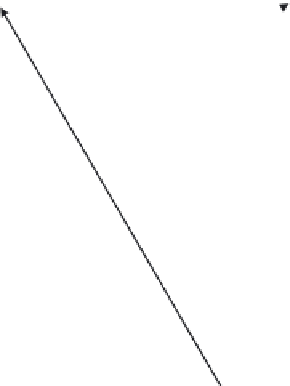Environmental Engineering Reference
In-Depth Information
Annulus
wheel
T
f
d
p
Planet
bearing
load
Planet
wheel
T
f
d
a
Sun
wheel
d
s
Figure 5: Half section epicyclic gear.
and weight, particularly in the fi rst two, high torque low speed stages, it is usual to
employ epicyclic gearing in which load is shared via three or more parallel load paths.
As shown in Fig. 5, such gears have the further advantage of having co-axial input and
output shafts rather than the offset parallel axes of a simple wheel and pinion.
The simplest form of epicyclic gear comprises three co-axial elements; a sun
wheel, a planet carrier, which provides a straddle mounting for a number of equi-
spaced planet wheels and an internally toothed ring gear or annulus. The fi gure
shows that the planet wheels serve as idlers (no residual torque) between the sun and
annulus wheels. If the planet carrier is fi xed, the sun and annulus rotate in opposite
directions, with the sun rotating at
−
R
times the speed of the annulus where
Nd
a
a
R=
Nd
(6 )
s
s
where
N
a
and
N
s
are the teeth numbers, and
d
a
and
d
s
are the pitch diameters of the
annulus (ring) and sun wheel, respectively.
It can be seen that the carrier has a torque reaction equal and opposite to the sum
of the sun and annulus torques. From this, it can be inferred that if the annulus is
fi xed then the sun will rotate at +(
R
+ 1) times the speed of the carrier and in the
same direction.
Conventionally, most simple epicyclic gears have three planets and to ensure
equal load sharing the sun is allowed to fl oat so that it can fi nd an axis which ensures
its equilibrium and compensates for the collective errors in the concentricity of the
respective axes of the sun wheel, planet carrier and annulus. This therefore requires
a suitable fl exible coupling to transmit the sun wheel torque.















Search WWH ::

Custom Search